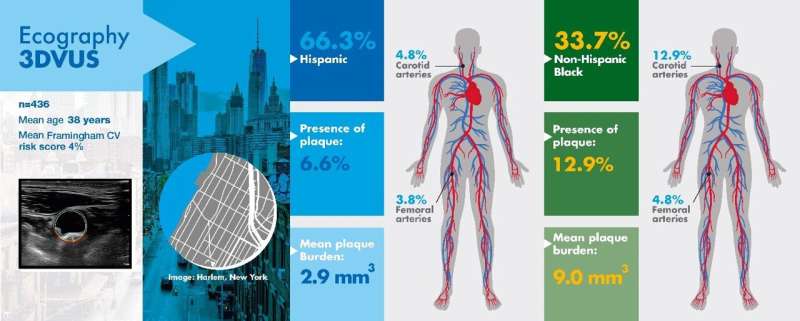
A unique Mount Sinai study focused on a multi-ethnic, underserved community in New York City shows that young Black adults are twice as likely to have atherosclerosis as similarly situated young Hispanic adults.
Atherosclerosis is plaque build-up in the arteries that can lead to a blockage, causing a heart attack or stroke. The research, published July 11 in the Journal of American College of Cardiology, is one of the first to evaluate atherosclerotic plaque in asymptomatic young urban populations and emphasizes the importance of early screening and lifestyle interventions in high-risk minority groups to improve their cardiovascular health.
“What’s interesting about this study is that Black individuals appear to be more vulnerable to atherosclerosis early in life than people of Hispanic origin, even when adjusting for known cardiovascular and lifestyle risk factors such as smoking, unhealthy diet, lack of exercise, high blood pressure, and cholesterol. This can then put them at increased risk of cardiovascular disease, suggesting the existence of emerging or undiscovered cardiovascular risk factors in this population,” says Valentin Fuster, MD, Ph.D., Director of Mount Sinai Heart and Physician-in-Chief of The Mount Sinai Hospital, who created and led the trial, called the FAMILIA Project at Mount Sinai Heart.
The study is part of an ambitious multinational effort to intervene early in the lives of children, their caretakers, and teachers so they can form a lifetime of heart-healthy habits. These new results come after highly successful interventions involving more than 500 preschoolers, caretakers, and educators at 15 Head Start schools in the Harlem section of Manhattan, an urban area that is socioeconomically disadvantaged—a situation commonly linked to higher rates of obesity, heart disease, and other health issues.
The FAMILIA team focused on 436 adults, including preschoolers’ family members, caretakers, teachers, and school staff. Of that group, 147 participants were Black and 289 were Hispanic, with an average age of 38; 80 percent were women. Each one answered a comprehensive questionnaire at the start of the study, addressing their nutrition, physical activity, tobacco use, alcohol consumption, and whether they had conditions such as heart disease, hypertension, diabetes, or a family history of health problems. They also had their weight recorded, and blood pressure and cholesterol checked.
Overall cardiovascular risk factors were prevalent for both ethnic groups at baseline. Thirty percent of Black participants had hypertension, almost triple the rate of the Hispanic group, 11 percent. Conversely, Black participants had lower rates of dyslipidemia—unhealthy levels of lipids/fat in the blood (18 percent) compared to the Hispanic group at 27 percent, and better eating habits, consuming more fruits and vegetables. Researchers used this data to calculate a predicted cardiovascular risk score for each group. They found the overall risk of having a cardiovascular event in 10 years was low for both Blacks and Hispanics—around four percent for both groups.
Participants also had 3D vascular ultrasounds to determine if they had atherosclerosis in their carotid (neck) and femoral (leg) arteries. These vascular ultrasounds pointed to a significant discrepancy between the groups. Overall, nine percent of participants had subclinical atherosclerosis (nearly one in ten participants showed at least one artery with plaque). Also, the rate of plaque buildup in the arteries was two times higher among Blacks than Hispanics. The results were consistent even after adjusting for classic cardiovascular risk factors including age, sex, body mass index, hypertension, diabetes, and cholesterol; lifestyle factors including diet, physical activity, and tobacco use; and socioeconomic factors such as employment status.
“These findings may in part help to explain the observed differences in cardiovascular disease prevalence between racial and ethnic groups,” Dr. Fuster adds. “The study further contributes to the understanding of higher rates of cardiovascular disease observed at an early age in disadvantaged communities. Until underlying biological factors and other undiscovered cardiovascular risk factors are better understood and can be addressed by precision medicine, affordable non-invasive imaging techniques such as the portable 3D vascular ultrasounds used in this study, which are easily used and affordable, can be an important form of early detection in underserved communities, and provide valuable information about population disparities and increase the precision of health promotion and prevention programs.”
Source: Read Full Article


